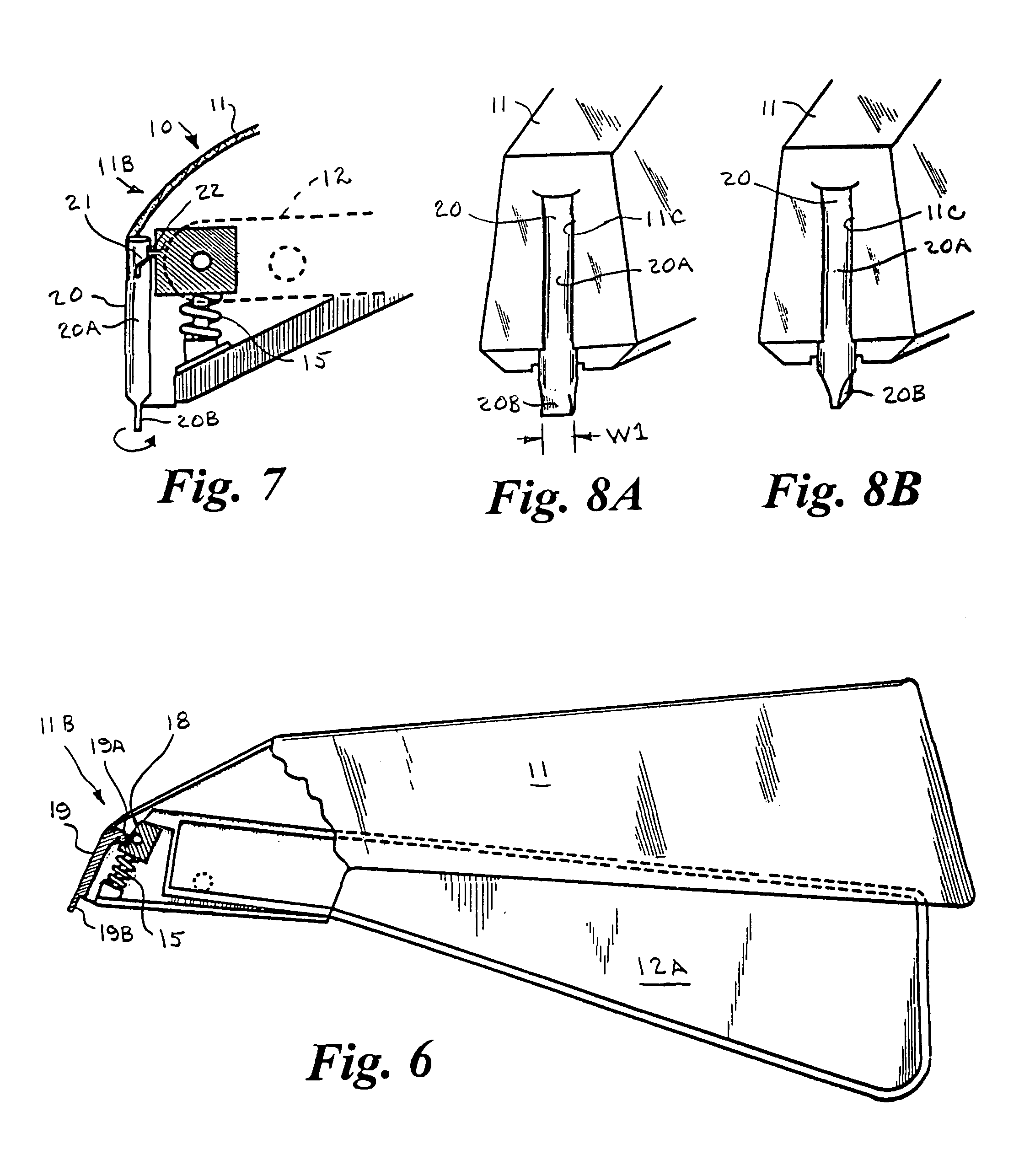Tissue aligning surgical stapler and method of use
a surgical stapler and tissue technology, applied in the field of surgical staplers, can solve the problems of enclosing too much tissue within the confines of closed staples, compromising both wound healing and resultant cosmetic appearance, and capturing too much tissue on closure, etc., to achieve rugged and reliable operation, simple construction, and low manufacturing cost
- Summary
- Abstract
- Description
- Claims
- Application Information
AI Technical Summary
Benefits of technology
Problems solved by technology
Method used
Image
Examples
second embodiment
[0056]FIG. 4 shows a tissue spacer 16 which is raised and lowered vertically by the operation of the trigger 12 of the stapler. In this embodiment, the tissue spacer 16 is a generally rectangular member slidably mounted in a recess formed in the front end 11B of the body 11. The tissue spacer 16 has a recess 16A in its back side which receives a tongue 17A of a cam member 17 rotatably mounted in the body 11. The opposed end of the cam 17 has an arcuate toothed surface 17B similar to a pinion gear which is engaged with a mating toothed rack 18 connected with the forward end of the trigger 12. The forward end of the trigger 12 is spring biased to a raised position by the return spring 15. When the trigger 12 is squeezed, the tissue spacer 16 is moved vertically upward relative to the stapler body by the cam 17, and when the trigger is released, the spacer is returned to its lowered position. The release of the stapler trigger 12 also advances the next staple into position in a convent...
third embodiment
[0057]FIG. 5 shows the tissue spacer 19 which is pivoted between a raised and lowered position by the operation of the trigger 12 of the stapler. In this embodiment, the tissue spacer 19 is a generally rectangular member pivotally mounted in a recess formed in the front end 11B of the body 11. The upper end of the tissue spacer 19 has an arcuate toothed surface 19A similar to a pinion gear which is engaged with a mating toothed rack 18 connected with the forward end of the trigger 12. The forward end of the trigger 12 is spring biased to a raised position by the return spring 15. When the trigger 12 is squeezed, the lower end of the tissue spacer 19 is pivoted upwardly and outwardly relative to the stapler body 11 by the arcuate toothed surface 19A, and when the trigger is released, the spacer pivoted back to its lowered position. The release of the stapler trigger 12 also advances the next staple into position in a conventional manner. In its lower position, the lower end 19B of th...
fourth embodiment
[0059]FIGS. 7, 8A and 8B show a tissue spacer 20 that is rotatable relative to the stapler body 11. In this embodiment, the tissue spacer 20 has an elongate cylindrical shank portion 20A which is rotatably mounted in a recess 11C formed in the front end 11B of the body 11, and a flat generally rectangular lower end 20B which depends a short distance beyond the bottom of the front end of the stapler body. The lower end 20B of the tissue spacer 20 has a width W1. The upper end of the tissue spacer 20 has a spiral groove 21 which receives a pin 22 secured to the forward end of the trigger 12. The forward end of the trigger 12 is spring biased to a raised position by the return spring 15. As shown in FIG. 8A, when the trigger 12 is released or in the relaxed condition and its forward end is raised, the flat rectangular lower end 20B of the tissue spacer 20 is positioned transverse to the longitudinal axis of the stapler body. As shown in FIG. 8B, when the trigger 12 is squeezed, the pin...
PUM
| Property | Measurement | Unit |
|---|---|---|
| width | aaaaa | aaaaa |
| distance | aaaaa | aaaaa |
| mechanical | aaaaa | aaaaa |
Abstract
Description
Claims
Application Information
 Login to View More
Login to View More - R&D
- Intellectual Property
- Life Sciences
- Materials
- Tech Scout
- Unparalleled Data Quality
- Higher Quality Content
- 60% Fewer Hallucinations
Browse by: Latest US Patents, China's latest patents, Technical Efficacy Thesaurus, Application Domain, Technology Topic, Popular Technical Reports.
© 2025 PatSnap. All rights reserved.Legal|Privacy policy|Modern Slavery Act Transparency Statement|Sitemap|About US| Contact US: help@patsnap.com



